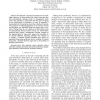621 search results - page 48 / 125 » Global partial orders from sequential data |
142
click to vote
CSCLP
2008
Springer
15 years 1 months ago
2008
Springer
In this paper, we present a rule-based modelling language for constraint programming, called Rules2CP. Unlike other modelling languages, Rules2CP adopts a single knowledge represen...
AINA
2010
IEEE
15 years 5 months ago
2010
IEEE
Abstract—We describe a Bayesian formalism for the intelligent selection of observations from sensor networks that may intermittently undergo faults or changepoints. Such active d...
RECSYS
2009
ACM
15 years 6 months ago
2009
ACM
Recommender systems aim to substantially reduce information overload by suggesting lists of similar items that users may find interesting. Caching has been a useful technique for...
101
click to vote
BMCBI
2007
15 years 3 hour ago
2007
Background: Natural antisense transcripts (NATs) are endogenous RNA molecules that exhibit partial or complete complementarity to other RNAs, and that may contribute to the regula...
132
click to vote
ICDE
2009
IEEE
14 years 9 months ago
2009
IEEE
There is a huge wealth of sequence data available, for example, customer purchase histories, program execution traces, DNA, and protein sequences. Analyzing this wealth of data to ...

